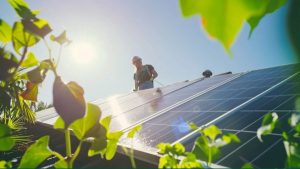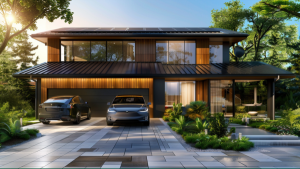Are you considering investing in solar panels? Well, here’s an eye-opening statistic for you: the average cost of solar panels in 2023 ranges from $17,430 to $23,870. But don’t let that deter you just yet! In this article, we’ll analyze the expenses involved and break down factors that impact the overall cost.
From system size and location to panel brand and roof characteristics, we’ll provide you with valuable insights to help you make an informed decision about this eco-friendly investment. So let’s dive into the world of solar panels and explore their high costs together.
Ready to revolutionize your energy consumption? The Infinite Energy System is here to lead the way. Say goodbye to traditional solar panels and hello to 80% lower power bills. Discover the clever solution and be amazed by the shocking proof today!
Key Takeaways
- The average cost of solar panels in 2023 ranges from $17,430 to $23,870, with an average installation cost of $20,650.
- The payback period for solar panels is around 8.7 years, and it depends on electricity rates and energy usage.
- Factors impacting the cost of solar panels include system size, location, panel brand and quality, panel type, and roof characteristics and complexity.
- SunPower panels have the highest average prices, while monocrystalline panels are the highest-performing but more expensive than polycrystalline panels. The characteristics of the roof, such as optimal sun exposure and complexity, can also affect the installation costs.
Average Cost of Solar Panels in 2023
The average cost of solar panels in 2023 is $20,650, which includes the installation cost. When considering installing solar panels, it’s essential to understand the process and expenses involved.
The solar panel installation process involves assessing your energy needs, determining the system size, selecting a reputable installer, and obtaining any necessary permits. Once installed, regular maintenance is required to ensure optimal performance and longevity.
Financing options for solar panels can make this investment more affordable by offering zero-down or low-interest loans. It’s also important to consider the warranty provided with your panels as it protects against any potential defects or malfunctions.
Lastly, solar panel efficiency should be taken into account as it determines how effectively the panels convert sunlight into electricity.
Payback Period for Solar Panels
Calculating the payback period for solar panels involves dividing the combined costs by annual financial benefits. The average payback period for solar panels is 8.7 years, making them a worthy investment.
The payback period depends on electricity rates and energy usage. Higher cost of electricity leads to shorter payback periods. To illustrate this, consider the following table:
| Electricity Rates | Energy Usage | Average Payback Period |
|---|---|---|
| High | High | 6 years |
| Medium | Medium | 8 years |
| Low | Low | 10 years |
As you can see, higher electricity rates and energy usage result in a shorter average payback period. By installing solar panels, you not only save money but also contribute to a sustainable future.
It’s important to consider the financial benefits, such as reduced utility bills and potential tax credits or incentives when evaluating the overall cost of solar panels. Take control of your energy costs and join the growing community of environmentally conscious individuals who are benefiting from solar power.
Factors Impacting the Cost of Solar Panels
When considering the factors that impact the cost of solar panels, you should take into account system size, location, panel brand and quality, panel type, and roof characteristics.
Installation considerations play a crucial role in determining the overall cost of solar panels. Factors such as the size of the system and its location can significantly influence the price.
Additionally, panel brand and quality are important considerations as they affect both performance and longevity. Different types of panels, such as monocrystalline or polycrystalline, also vary in price.
Moreover, roof characteristics such as orientation and complexity can impact installation costs. It’s worth noting that government incentives may help offset some of these expenses.
Maintenance costs should also be taken into account when calculating the total cost over the lifespan of solar panels.
Lastly, battery storage options can provide backup power during grid outages but come with an additional cost to consider.
System Size and Location
To determine the size and location of your solar system, you’ll need to consider factors such as available space, sun exposure, and your energy needs.
- System Size: A larger system with more panels will cost more initially but can save you more in the long run by generating more electricity.
- Installation Process: The installation process varies based on your location and the complexity of your roof structure. Factors like multiple levels or skylights may increase installation costs.
- Government Incentives: Many states offer incentives such as rebates or tax credits to encourage solar adoption. These incentives can significantly reduce the upfront cost of installing a solar system.
Panel Brand, Type, and Roof Characteristics
If you’re considering solar power, it’s important to consider factors like panel brand, type, and roof characteristics that can impact the overall price of your system.
Panel quality plays a significant role in determining the cost of solar panels. Well-made, high-efficiency panels like SunPower tend to have higher average prices.
Installer experience and warranty coverage are also crucial considerations when evaluating costs. Additionally, the type of panel chosen, whether monocrystalline or polycrystalline, affects pricing. Monocrystalline panels are generally more expensive but offer higher performance compared to polycrystalline panels.
Roof complexity is another factor influencing expenses. A south-facing roof with optimal sun exposure requires fewer panels and lowers costs.
On the other hand, roofs with multiple levels, dormers, or skylights may incur additional installation costs. Make sure to account for these factors when assessing the total expenses of installing solar panels on your property.
| Factors | Impact |
|---|---|
| Panel Brand | Higher-quality brands tend to have higher prices |
| Installer Experience | More experienced installers usually charge more |
| Warranty Coverage | Longer warranties may result in higher upfront costs |
| Panel Type (Monocrystalline vs Polycrystalline) | Monocrystalline panels are generally more expensive but offer better performance |
| Roof Complexity | Complex roof structures may require additional equipment and increase installation costs |
Remember that investing in a reliable and efficient solar power system can provide long-term savings on energy bills while reducing your carbon footprint.
Frequently Asked Questions
Are There Any Government Incentives or Rebates Available to Help Offset the Cost of Installing Solar Panels?
Yes, there are government incentives and rebates available to help offset the cost of installing solar panels. These include tax credits, financial assistance programs, and other cost reduction opportunities.
How Does the Cost of Solar Panels Compare to the Cost of Traditional Electricity Sources?
The cost of solar panels is competitive with traditional electricity sources. In addition to cost comparison, solar panels offer environmental benefits, long-term savings, reliable energy, and advancements in technology.
Can Solar Panels Be Installed on Any Type of Roof, or Are There Certain Requirements?
Solar panels can be installed on a variety of roofs, but there are certain requirements. Consider roof compatibility, installation requirements, panel durability, output efficiency, and aesthetic considerations for a successful installation.
What Maintenance or Upkeep Is Required for Solar Panels, and Are There Additional Costs Associated With This?
Maintenance costs for solar panels include cleaning and occasional repairs. The lifespan of panels is typically 25-30 years, with warranty coverage provided by manufacturers. Unexpected repair expenses may arise, but overall upkeep costs are minimal.
Are There Any Potential Risks or Drawbacks to Installing Solar Panels That Should Be Considered Before Making the Investment?
Before making the investment, it’s important to consider potential risks and drawbacks of installing solar panels. These may include upfront costs, variable energy savings, system maintenance, and limited efficiency in certain weather conditions.
Step into the future of energy with the Infinite Energy System. This incredible device is not only 98% cheaper, but it also takes up only 5% of the space of regular solar panels. Experience an 80% reduction in your power bills and be part of the household revolution. Don’t hesitate, grab your Infinite Energy System today!
Conclusion
So, you’ve seen the numbers and analyzed the expenses. The high costs of solar panels can be daunting, but don’t let that dim your enthusiasm for going green. Think of solar panels as an investment in a brighter future.
Consider the factors impacting cost, like system size, location, panel brand and quality, type, and roof characteristics. Remember, bigger systems may mean bigger costs upfront, but they save more in the long run. And don’t forget about those SunPower panels with their stellar efficiency – though they come at a higher price tag.
Take your time to carefully consider all these factors before making a decision because when it comes to solar power systems, every detail counts.




